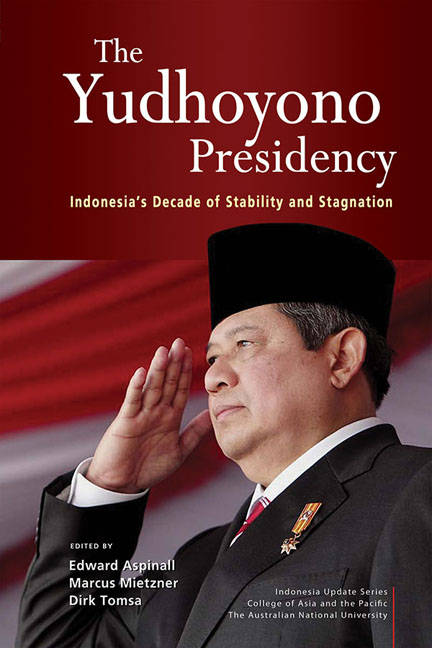Book contents
- Frontmatter
- Contents
- Tables and figures
- Contributors
- Acknowledgments
- Glossary
- 1 The moderating president: Yudhoyono's decade in power
- 2 Prologue Yudhoyono's legacy: an insider's view
- PART 1 PERSONAL, COMPARATIVE AND INTERNATIONAL PERSPECTIVES
- PART 2 INSTITUTIONS, POLITICS AND SECURITY
- 6 A balancing act: relations between state institutions under Yudhyono
- 7 Professionalism without reform: the security sector under Yudhoyono
- 8 Yudhoyono's legacy on internal security: achievements and missed opportunities
- 9 Toning down the ‘big bang’: the politics of decentralisation during the Yudhoyono years
- 10 The rule of law and anti-corruption reforms under Yudhoyono: the rise of the KPK and the Constitutional Court
- PART 3 GENDER, HUMAN RIGHTS AND ENVIRONMENT
- PART 4 THE ECONOMY AND SOCIAL POLICIES
- Index
- Miscellaneous Endmatter
6 - A balancing act: relations between state institutions under Yudhyono
from PART 2 INSTITUTIONS, POLITICS AND SECURITY
Published online by Cambridge University Press: 19 May 2017
- Frontmatter
- Contents
- Tables and figures
- Contributors
- Acknowledgments
- Glossary
- 1 The moderating president: Yudhoyono's decade in power
- 2 Prologue Yudhoyono's legacy: an insider's view
- PART 1 PERSONAL, COMPARATIVE AND INTERNATIONAL PERSPECTIVES
- PART 2 INSTITUTIONS, POLITICS AND SECURITY
- 6 A balancing act: relations between state institutions under Yudhyono
- 7 Professionalism without reform: the security sector under Yudhoyono
- 8 Yudhoyono's legacy on internal security: achievements and missed opportunities
- 9 Toning down the ‘big bang’: the politics of decentralisation during the Yudhoyono years
- 10 The rule of law and anti-corruption reforms under Yudhoyono: the rise of the KPK and the Constitutional Court
- PART 3 GENDER, HUMAN RIGHTS AND ENVIRONMENT
- PART 4 THE ECONOMY AND SOCIAL POLICIES
- Index
- Miscellaneous Endmatter
Summary
When Susilo Bambang Yudhyono was sworn into office in October 2004, he was stepping into a set of constitutional arrangements and political circumstances that was without historical precedent in Indonesia. Following the constitutional reforms of 1999–2002, Yudhoyono faced the task of managing new and untested relationships among the major institutions of state, especially between the presidency and the parliament (Dewan Perwakilan Rakyat, DPR). But while Yudhoyono was Indonesia's first directly elected president, popular and elite views of the office of the presidency were characterised by a sense of continuity rather than difference. There was a widespread, if unspoken, assumption that Yudhoyono was occupying the same office as his predecessors, just doing so in a democratic environment. Echoing this default view, Anies Baswedan (2007: 232) explained that ‘an important and enduring feature of Indonesian politics has been the dominance of the president. … Indonesia's first two presidents set a precedent for the role and stature of their successors’. Clearly, the towering figures of Sukarno and Suharto had stamped an indelible impression on the minds of Indonesians that the president was the most powerful personage in the land.
This left a legacy of expectations for Yudhoyono about the supposedly superior role and power of the presidency. Thus, when the parliament, with its new constitutional powers and popular legitimacy, asserted itself on a number of occasions during his presidency, some observers believed that the relative powers of the executive and legislative branches had become unbalanced and, even more importantly, that the DPR was attempting to usurp the powers of the president (Susanti 2006; Indrayana 2008: 274–5). Common arguments were that Indonesia had moved from an ‘executive-heavy’ system under Suharto to a ‘legislative-heavy’ system in the democratic era and that Yudhoyono's reform agenda had been obstructed by reactionary forces in the DPR (Perdana and Friawan 2007: 19; Purnomo 2008). However, there have been few scholarly studies to test such assumptions.
This chapter discusses the ways in which Yudhoyono managed the relationships between key state institutions in Indonesia's reformed presidential system. The first section shows that Yudhoyono inherited a presidency whose relationships with other parts of government, especially the legislature, were still in the process of redefinition.
- Type
- Chapter
- Information
- The Yudhoyono PresidencyIndonesia's Decade of Stability and Stagnation, pp. 93 - 113Publisher: ISEAS–Yusof Ishak InstitutePrint publication year: 2015

